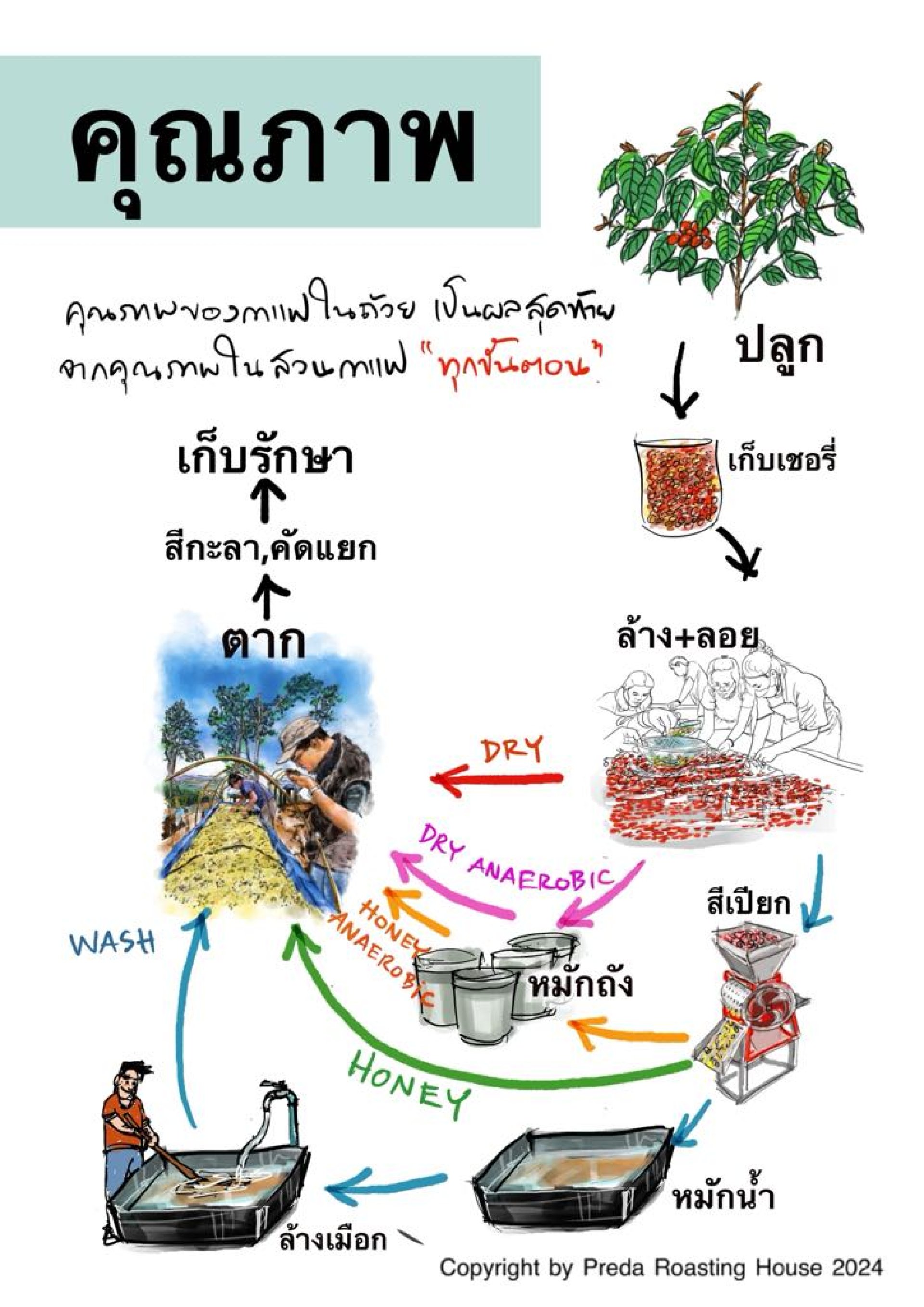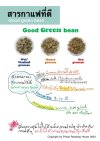The Basics of Coffee Processing 2

The Basics of Coffee Processing 2
Quality Coffee Beans: The Result of Care in Every Step
Read Chapter 1 [Click Here]From cultivation and harvesting to processing, coffee involves many intricate steps that require knowledge, understanding, and dedication all aimed at one shared goal: Cup Quality, or the quality of the coffee in your cup.
Here, I want to emphasize one crucial mindset for coffee growers:
Think about the people who will drink your coffee.
If your coffee nourishes both the body and mind of the drinker, your work will thrive sustainably. When coffee makes someones day better, your farm and your craft will flourish in return.
This mindset is quite different from the usual approach of producing beans just to sell to a mill or roastery. When you see your work as creating energy and happiness for someone else, every step naturally becomes more meaningful and meticulous.
Another key idea:
Producing quality green coffee requires quality at every stage of the process. Any contamination or damage at one step will show up later as a defect in the green bean itself.
So, if we want truly good green beans, we must pay attention to every single step from planting, harvesting, sorting, washing, pulping, fermenting, drying, resting, to storage.
All these processes can be learned by anyone; theyre not difficult its just that knowledge about processing has often been scattered and not clearly connected into a single, systematic picture.
Overview of Coffee Production and Processing
1. Growing and Caring for Coffee TreesArabica coffee, the variety used for high-quality beans, needs the right environment typically at elevations between 800 and 2,000 meters above sea level (in Thailand, up to around 1,700 meters). Higher altitudes allow slower growth and more nutrient accumulation, creating more complex flavors.
Key aspects of coffee cultivation include:
- Selecting the right planting site: fertile, well-drained soil with adequate but not excessive sunlight.
- Proper seedling cultivation: strong roots from the start help ensure healthy trees and better yields.
- Spacing: trees should be planted at least 2 meters apart to allow proper airflow and nutrient distribution.
- Soil management: analyze and improve soil nutrients, adjust pH for healthy root uptake, and plant cover crops like legumes to fix nitrogen.
- Organic matter: adding organic debris like wood or leaves enriches the soil naturally and attracts earthworms that aerate the soil.
- Weed control: simply cutting grass instead of using herbicides helps increase soil organic matter.
- Pest and disease management: clean the farm after harvest to prevent pests, ensure airflow, and use natural methods whenever possible.
- Pruning: reduce excess branches to help the plant channel energy into fruiting and to prevent fungal diseases like rust or anthracnose.
2. Harvesting and Sorting Coffee Cherries
Harvesting directly affects quality. Cherries should be picked when fully ripe.Two main methods are used:
- Hand-picking: selecting only fully ripe cherries ideal for specialty coffee.
- Mechanical harvesting: used for large-scale production but often results in uneven quality.
After harvesting, cherries are sorted unripe, ripe, overripe, and defective cherries are separated. They are then washed and floated to remove lightweight or poor-quality cherries.
This pre-sorting step allows for better processing management. For example, overripe cherries may already have natural fermentation and can go directly to drying, while ripe ones are suitable for controlled fermentation.
In reality, producers can handle both specialty and commercial coffee simultaneously as long as cherries are properly sorted and processed separately, avoiding loss in quality or value.
Coffee Processing: The Art and Science of Flavor
Processing plays a decisive role in shaping aroma, flavor, and overall quality.
The three main processing methods are:
- Washed ProcessThis
method produces clean, bright coffee.
Steps: wash and float to remove light cherries > pulp > ferment in water to remove mucilage > wash again dry.
Pros: clean, balanced
flavor: that highlights the beans natural profile.
Cons: requires a lot of water - Honey Process
Cherries are pulped but some mucilage is left on before drying. This sticky layer enhances sweetness and complexity.
Pros: sweet, layered, and unique flavor.
Cons: sticky mucilage makes turning the beans during drying difficult, sometimes causing unevenness. - Dry or Natural Process
The oldest method: whole cherries are sun-dried before hulling.
Pros: intense, fruity, and suitable for areas with limited water.
Cons: longer drying time and high weather dependency can affect quality.
Anaerobic Fermentation
A modern approach that ferments coffee in oxygen-free environments, using sealed tanks with controlled temperature and variables. It can be applied to both honey and natural processes.
Pros: creates novel, complex flavors.
Cons: improper fermentation may result in unpleasant off-flavors.
Clean Cup
A Clean Cup is the heart of specialty coffee. It can be defined simply by three traits:
1. No negative or unpleasant flavors.
2. Safe for consumption not harmful to health.
3. Interesting and attractive flavor profile which often determines both popularity and price.
A clean, safe coffee almost always tastes clean and pleasant, easy to drink, and comfortable to enjoy.
The step that defines a Clean Cup most directly?
Coffee Processing.
GOOD GREEN BEAN
Before diving into technical processes, lets define what makes a Good Green Bean:
1. Normal color and appearance appropriate to its process.
2. Clean, natural smell no foul or sour odor.
3. Defects within acceptable standards.
4. Moisture content between 912%.
5. Density above 640 g/L.
If a bag of coffee meets all five criteria, it qualifies as good-quality green coffee.
However, sometimes beans look fine but reveal off-flavors after roasting which is why cupping tests are always necessary before final grading.
Conclusion
Great coffee is the result of care at every stage from planting to brewing.
In particular, cultivation and processing play the most significant roles in determining final cup quality.
Read Chapter 3 [Click Here]
Accurate knowledge and genuine intention these are the true heart of good coffee.
Its a long read, I know. But thats the nature of coffee science its never really short.
Thank you.





